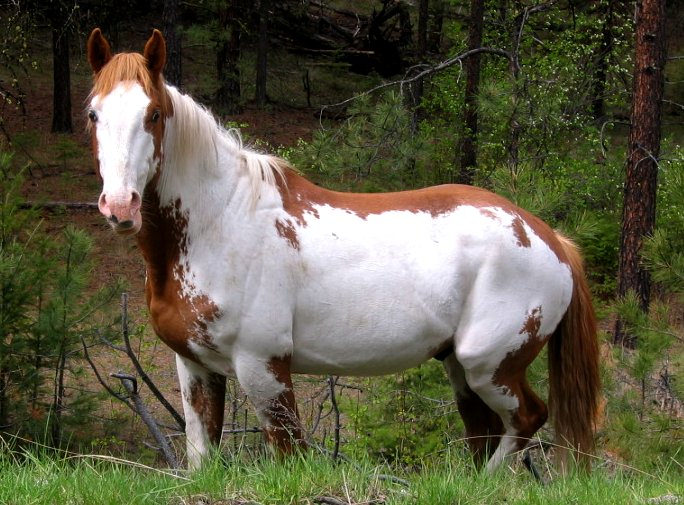

Exotic Ungulates in British Columbia
by David Shackleton
(Extracted with permission from Hoofed Mammals of British Columbia, Revised Edition)
Two categories of exotic (non-native) ungulates occur in British Columbia--feral and introduced species. A feral species is a domestic species now living free without human control. There are three species of feral ungulates in the province: horses, sheep and goats.

Feral horse in the southern Okanagan, photo by Brian Klinkenberg
Feral horses are found mainly in the central interior, west of Williams Lake. Some were present in the interior when European explorers first arrived in BC. Presumably, they originated from horses brought to the southwestern United States by the Spanish in the 17 century; later, First Peoples brought these horses northward. Feral horses are considered pests by some people, so they are hunted and rounded up.
Domestic Sheep and Goats were common livestock raised along BC's Inside Passage. Most feral populations of these species probably resulted from animals that escaped or were abandoned when farms closed. A small number of feral sheep still live on Saturna, Saltspring and Lasqueti Islands. Feral goats are found on Jedediah, Lasqueti, Saturna and Texada Islands, and may still exist on Pender Island. A feral goat population on Saltspring Island appears to have been eradicated in the late 1980s, and one on Sidney Island has also been exterminated.
Feral cattle were once found in various parts of the province including the Tofino area, Estevan Point and Cape Scott on the west coast of Vancouver Island, and on the northern and eastern parts of Graham Island in Haida Gwaii. It's almost certain that feral cattle no longer exist on Vancouver Island, although there are unconfirmed reports of some on an island off the west coast. Only a small population of about 12 animals possibly still survive in the eastern part of Naikoon Provincial Park, slightly north of Tlell on Graham Island. The first cattle on Haida Gwaii were released in 1886 by the Hudson's Bay Company near Massett. Then, at the beginning of World War I, the feral population increased when settlers leaving for the war freed their animals. More recently, at least two herds were abandoned as late as the 1960's. These releases explain why there are traces of most major British dairy and beef breeds among the remaining feral animals. But long ago, they lost all traces of tameness and are harder to approach than the local deer.
The most unlikely feral species to have occurred in BC was the Bactrian Camel, the large shaggy-haired, two-humped camel of central Asia. During the Cariboo Gold Rush, around 1852, 22 camels were imported as pack animals. They proved unsuitable and some were released in the Lac La Hache and Westwold areas. The small feral population appears to have died out around 1905.
One domestic ungulate species that almost became feral in the province was the Wild Boar. Some of these were illegally introduced into an area near Harrison Hot Springs and others on the east side of Cultus Lake. Fortunately, the released animals did not survive--if they had, they could have been a serious pest problem. Introductions of non-native species are almost always a biological and economic disaster, and so must be avoided at all costs. It is important to recognize that as long as there is at least one of each sex in a small group, it can grow to a large population and become widespread. A recent analysis by D. M. Forsyth and R. P. Duncan of ungulates introduced into New Zealand has shown that as few as a single pair of ungulates can result in a successful introduction, and that liberation of six or more animals were always successful. With so few founder animals capable of establishing a large population, the eradication of introduced ungulates can be very difficult, if not impossible, and certainly economically costly. These recent findings underscore the importance of avoiding introductions (whether planned or accidental) of non-native species.
Two non-native wild species have also been introduced and allowed to roam free in parts of BC, but only one still survives. European Red Deer brought from New Zealand in 1914 and in 1918 were released near Massett on Haida Gwaii. The population increased until the beginning of the Second World War, but then declined, presumably from over-hunting by armed forces personnel. There are no recent records of any survivors. The second introduced species is the Fallow Deer, and populations still exist on some of the southern Gulf Islands, along with several substantiated reports in the lower Fraser Valley.
Selected References:
Cannings and Cannings, 1996, Carl and Guiguet 192, Cowan and Guiduet 1965, Shank 1972.
Please cite these pages as:
Author, date, page title. In: Klinkenberg, Brian. (Editor) 2021. E-Fauna BC: Electronic Atlas of the Fauna of British Columbia [www.efauna.bc.ca]. Lab for Advanced Spatial Analysis, Department of Geography, University of British Columbia, Vancouver. [Date Accessed]
© Copyright 2021 E-Fauna BC.